-inman.jpg)
The Inman Line steamship City of New York (3) - from an amateur photo taken in 1890
Support Norway Heritage: Purchase a copy 
The Inman Line steamship City of New York (3) - deck view
Support Norway Heritage: Purchase a copy -inman.jpg)
The Inman Line steamship City of New York (3)
Support Norway Heritage: Purchase a copy 
S/S New York of the Inman Line, later of the American Line
Support Norway Heritage: Purchase a copy
At the time of her launch the City of New York was the largest passenger steamer afloat. She was built with a clipper stem, three funnels, three masts, twin screws and a speed of 20 knots. There was accommodation for 540-1st, 200-2nd and 1,000-3rd class passengers, all together she had accommodations for 2,000 persons crew included. There were five decks in the ship, and she was built with a double bottom. The promenade deck was flush from stem to stern, covered on top and open at the sides, affording the passengers ample space for their daily airing. One of the most pleasing features about the ship's construction, and one to which particular attention had been given by her designers, was the handsome dining saloon. It was situated forward on the upper deck, and in order to avoid the low ceiling which was common aboard ships at the time, the roof of the saloon was carried up above the top of the house on the hurricane deck, or about 20 feet. The ceiling was supported by a steel arch 33 feet long and with 23 feet of span. It was provided with stained-glass windows or skylights protected above by the skylights and frames. The dining room had along its sides a number of recesses or compartments for private tables. The room could seat 300 diners. The large pantries, one on each side of the saloon, were connected by lifts with the galley which was situated on the deck below. At the after end of the saloon was a large hall opening upon the grand stairway leading to the promenade deck.

First class dining saloon, City of New York
The main first-class saloon and library were also reached by this stairway, the former was forward of the library above the entrance hall of the dining saloon. Those rooms were all elegantly furnished throughout. The library was amply provided with literature. Aft of the funnels on the upper deck provision had been made for a dining room for children and nurses. The first-class smoking room was situated on the upper deck at the after end of the ship, and was 45 feet long, 27 feet wide, and had ample room for 130 people. The bar was a very handsome apartment, upholstered in ornamental leather, with American walnut panels. The first-class staterooms and suites of apartments were situated on four decks, within 155 feet of the ship's waist. The largest and best were those on the promenade and upper deck. There were 25 sitting rooms or saloons for day use, and altogether sleeping accommodations for 479 first-class passengers.

The second-class passengers were provided for on the main and lower decks, the dining room was situated aft on the upper deck. It was 27 feet long and 40 feet wide, with room for 150 persons. The other apartments of the second class passengers, including 96 staterooms, were situated on the after end of the main and lower decks. The
steerage passengers were quartered at the two extreme ends of the lower and main decks. Their berths were in the middle of the vessel which left both sides of their cabins for day occupation. Petty officers and crew were accommodated forward. The ship was well ventilated and was lighted by electricity.
Her engine power exceeded that of any other merchant steamer yet built, and was 20,000 horse power. The
Umbria and
Etruria of the
Cunard Line, the fastest Atlantic vessels at the time had engines of 14,321 horse power. She had one set of twin screws, with
triple expansion engines. The engines could work independently of each other. Each of the engines was located in their own water-tight compartment. The boilers which supplied the steam were fitted in three separate water-tight compartments, divided from each other by transverse bulkheads. There were nine boilers, of steel, weighing 74 tons. The appliance for forcing a draught in the boilers was fitted on the same principle as that used in the navy and was called the Stakehold system. It was the first time that was used on an Atlantic steamship.

S/S City of New York (3), engraving from Scientific American, 1893

The bridge
The main saloon was just forward of the bridge. It was surmounted by a magnificent iron arched roof, 63 feet long and 25 feat wide. This roof was double, the inside being of stained glass in artistic designs. Between this glass and the outer roof were hundreds of incandescent lights. At, night the outer roof was closed by iron shutters and the saloon brilliantly illuminated.

The S/S City of New York as the New York in American Line service, some time after the ship was rebuilt. As can be seen, one of the funnels was removed.
| 
Twin screws on the S/S City of New York
|